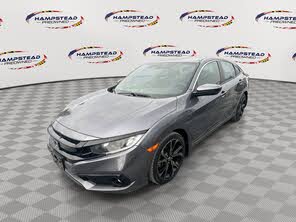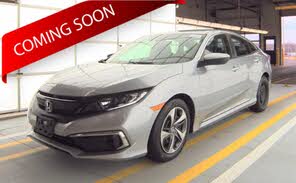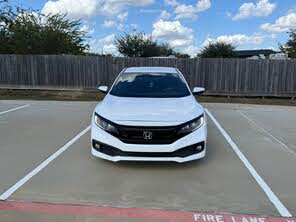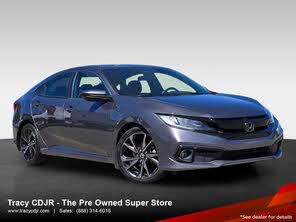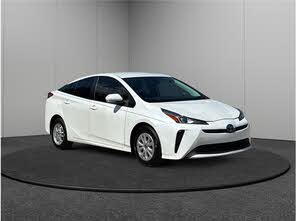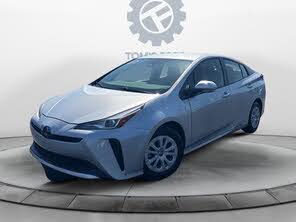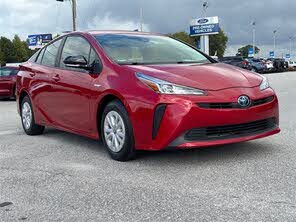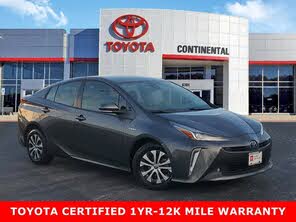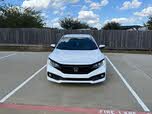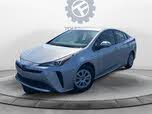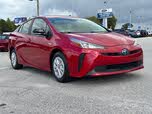2020 Honda Civic vs 2021 Toyota Prius
Overview | |
MSRP$20,000 | MSRP$24,525 |
Listings1577 | Listings154 |
Ratings & Reviews | |
User Reviews | User Reviews |
Expert reviews8.2 out of 10 | Expert reviews6.2 out of 10 |
Pros
Cons
| Pros
Cons
|
2020 Honda Civic Reviews SummaryMinor design tweaks, more standard safety and convenience features, and more manual transmissions arrive as the standout changes for the Civic's 2020 model year. Last redesigned for the 2016 model year, the Civic keeps outperforming its small-car peers by offering the performance and quality of more expensive cars, while retaining the value and longevity expected of a Honda. Plus, I had a really fun week with the turbocharged Civic Si. | |
2021 Toyota Prius Reviews SummaryTo many people, cars are appliances made to serve a function. These consumers own a car because they need to get from where they are to where they’re going, and with a minimum of hassle, expense, or discomfort. Reliability, efficiency, safety, and economy are the critical deciding factors, and the 2021 Toyota Prius delivers on all fronts. Confusingly, for 2021, the Prius lineup offered a 2020 Edition. Toyota built just 2,020 examples to commemorate the 20th anniversary of the first Prius sold in the U.S. market. It has blacked-out trim, black 17-inch wheels, a body-color rear spoiler, and comes in Supersonic Red or new Wind Chill paint colors. Additionally, Toyota improved the 2021 Prius’s driving-assistance systems by making Toyota Safety Sense 2.0 standard across the board. Android Auto is also standard (joining Apple CarPlay), except for the unique infotainment system in the Prius Limited. | |
No video found | |
Popular Features & Specs | |
Engine2.0L 158 hp I4 | Engine1.8L 121 hp I4 Hybrid |
Drive TrainFWD | Drive TrainFWD |
Seating Capacity5 | Seating Capacity5 |
Horsepower158 hp @ 6500 rpm | Horsepower |
EV Battery Capacity | EV Battery Capacity0.7 kWh |
MPG City25 | MPG City58 |
MPG Highway36 | MPG Highway53 |
Engine | |
Engine Name2.0L 158 hp I4 | Engine Name1.8L 121 hp I4 Hybrid |
Torque138 lb-ft @ 4200 rpm | Torque |
Horsepower158 hp @ 6500 rpm | Horsepower |
DrivetrainFWD | DrivetrainFWD |
Fuel Economy | |
EV Battery Capacity | EV Battery Capacity0.7 kWh |
MPG City25 | MPG City58 |
MPG Highway36 | MPG Highway53 |
Interior | |
Seating Capacity5 | Seating Capacity5 |
Safety | |
Front Crash Overall5 | Front Crash Overall4 |
Side Crash Overall5 | Side Crash Overall5 |
Dimensions & Capacity | |
Cargo Space15.1 cu ft | Cargo Space27.4 cu ft |
Curb Weight2762 lbs | Curb Weight3010 lbs |
Height55.7 in | Height57.9 in |
Length182.7 in | Length180.0 in |
Width70.8 in | Width69.3 in |
Wheelbase106.3 in | Wheelbase106.3 in |
Maximum Payload1007 lbs | Maximum Payload825 lbs |
Number of doors4 | Number of doors4 |
Overview | ||
MSRP | $20,000 | $24,525 |
Listings | ||
Ratings & Reviews | ||
User reviews | ||
Expert reviews | 8.2 out of 10Read full review | 6.2 out of 10Read full review |
Pros & cons | Pros
Cons
| Pros
Cons
|
Summary | Minor design tweaks, more standard safety and convenience features, and more manual transmissions arrive as the standout changes for the Civic's 2020 model year. Last redesigned for the 2016 model year, the Civic keeps outperforming its small-car peers by offering the performance and quality of more expensive cars, while retaining the value and longevity expected of a Honda. Plus, I had a really fun week with the turbocharged Civic Si. | To many people, cars are appliances made to serve a function. These consumers own a car because they need to get from where they are to where they’re going, and with a minimum of hassle, expense, or discomfort. Reliability, efficiency, safety, and economy are the critical deciding factors, and the 2021 Toyota Prius delivers on all fronts. Confusingly, for 2021, the Prius lineup offered a 2020 Edition. Toyota built just 2,020 examples to commemorate the 20th anniversary of the first Prius sold in the U.S. market. It has blacked-out trim, black 17-inch wheels, a body-color rear spoiler, and comes in Supersonic Red or new Wind Chill paint colors. Additionally, Toyota improved the 2021 Prius’s driving-assistance systems by making Toyota Safety Sense 2.0 standard across the board. Android Auto is also standard (joining Apple CarPlay), except for the unique infotainment system in the Prius Limited. |
Video | No video found | |
Popular Features & Specs | ||
Engine | 2.0L 158 hp I4 | 1.8L 121 hp I4 Hybrid |
Drive Train | FWD | FWD |
Seating Capacity | 5 | 5 |
Horsepower | 158 hp @ 6500 rpm | |
EV Battery Capacity | 0.7 kWh | |
MPG City | 25 | 58 |
MPG Highway | 36 | 53 |
Engine | ||
Engine Name | 2.0L 158 hp I4 | 1.8L 121 hp I4 Hybrid |
Torque | 138 lb-ft @ 4200 rpm | |
Horsepower | 158 hp @ 6500 rpm | |
Drivetrain | FWD | FWD |
Fuel Economy | ||
EV Battery Capacity | 0.7 kWh | |
MPG City | 25 | 58 |
MPG Highway | 36 | 53 |
Interior | ||
Seating Capacity | 5 | 5 |
Safety | ||
Front Crash Overall | 5 | 4 |
Side Crash Overall | 5 | 5 |
Dimensions & Capacity | ||
Cargo Space | 15.1 cu ft | 27.4 cu ft |
Curb Weight | 2762 lbs | 3010 lbs |
Height | 55.7 in | 57.9 in |
Length | 182.7 in | 180.0 in |
Width | 70.8 in | 69.3 in |
Wheelbase | 106.3 in | 106.3 in |
Maximum Payload | 1007 lbs | 825 lbs |
Number of doors | 4 | 4 |
The 2020 Honda Civic was a standout in Honda's lineup, offering a range of choices and engineering excellence typically found in higher-end brands. It came in three body styles—sedan, coupe, and 4-door hatchback—each showcasing a sharp design. The sedan featured a sleek roofline, while the coupe and hatchback had their own unique, eye-catching elements. The 2019 model year brought updates to the grilles, bumpers, and wheels, which carried over into 2020. The Civic Si sedan and coupe received new matte-black 18-inch wheels, LED fog lights, and other stylish updates. The interior was simple yet high-quality, with soft-touch materials and pleasing design elements.
In contrast, the 2021 Toyota Prius retained its iconic boomerang-shaped hood and roofline, a design choice that had become ingrained in its identity. However, this styling was not universally praised. The interior was unconventional, with a strip of displays mounted in the center of the dashboard and a toggle lever for transmission controls. The infotainment pod was thrust toward the front seat occupants, and the gloss-black trim attracted dust and fingerprints. The Prius was available in multiple trims, including an AWD option, but its design and interior layout were not as universally appealing as the Civic's.



The 2020 Honda Civic offered a variety of engines and transmissions, all front-wheel drive. The base LX and Sport trims featured a 2.0-liter inline 4-cylinder engine with 158 horsepower and 138 pound-feet of torque. A 6-speed manual transmission was standard on these trims, while a CVT was optional. Higher trims came with a turbocharged 1.5-liter inline-4 engine, producing 174 hp and 162 lb-ft of torque. The hatchback versions in Sport or Sport Touring trims made 180 hp. The Civic Si and Type R models offered even more power, with the Si boasting 205 hp and the Type R an impressive 306 hp. The Civic's engines were smooth and responsive, making it a joy to drive. Fuel economy was also commendable, with most models achieving at least 30 mpg city and up to 42 mpg highway.
The 2021 Toyota Prius focused on fuel efficiency, with the L Eco version achieving an impressive 56 mpg combined according to the EPA. Other front-drive models earned a 52 mpg combined rating, while AWD-e models managed 49 mpg. The Prius paired a 1.8-liter four-cylinder gasoline engine with a 53-kilowatt electric motor, producing a total system output of 121 horsepower. While this wasn't much power, the electric motor's torque made the Prius feel lively off the line. The car offered various driving modes to maximize efficiency, and its TNGA platform provided a lower center of gravity for better handling. However, the Prius was not particularly fun to drive, with hard acceleration producing a droning noise and the steering lacking road feel.
The 2020 Honda Civic offered a well-thought-out interior with practical features. The 2019 updates included a volume knob and better cupholders, and the hatchback received more sound insulation. The driver's seat on EX hatchback models was eight-way power adjustable. The steering wheel had controls for the central display and instrument panel, and the center console offered configurable storage. The Civic felt roomy for rear passengers, although it lacked rear air vents. Cargo space was generous, with the sedan offering 15 cubic feet, the coupe 12 cubic feet, and the hatchback 26 cubic feet behind the rear seats and 46 cubic feet with them folded down.
The 2021 Toyota Prius, often perceived as a small car, offered more interior space than expected. It could seat up to five people, with comfortable seats covered in SofTex synthetic leather. The test vehicle had an eight-way power driver’s seat, heated front seats, and a heated steering wheel. However, the low seating position made entry and exit more difficult. The rear seats provided adequate space but lacked air-conditioning vents. Cargo space varied by trim, ranging from 24.6 to 27.4 cubic feet behind the back seat and 47.9 to 50.7 cubic feet with the seats folded down.
The 2020 Honda Civic featured an outdated 7-inch touchscreen infotainment system, standard on all models except the base LX. It included Apple CarPlay and Android Auto, but the interface was slow and complex. The Civic Si introduced Active Sound Control, which could be turned off, and came with a 450-watt, 10-speaker stereo. Other features included push-button start, keyless entry, a power moonroof, and heated front seats. Honda Sensing was standard on all trims, offering active lane centering, adaptive cruise control, and auto high beams.
The 2021 Toyota Prius had a 7-inch touchscreen infotainment system with stereo-volume and tuning knobs, and shortcut buttons. Standard features included Bluetooth, SiriusXM satellite radio, Apple CarPlay, Android Auto, and Amazon Alexa compatibility. Higher trims offered a 10-speaker JBL premium sound system, navigation, and a natural voice recognition system. The Limited trim featured an 11.6-inch portrait-style touchscreen, but it lacked the Android Auto upgrade. The digital instrumentation was dated and lacked sophistication.
The 2020 Honda Civic came with Honda Sensing, which included forward collision warning, emergency forward braking, lane-keeping assist, and adaptive cruise control. The Civic earned a Top Safety Pick rating from the IIHS for all body styles except the Type R. It received the top "Good" rating in all six crash tests. The NHTSA rated the Civic five stars in all categories, except for four stars in the passenger frontal crash rating on the coupe.
The 2021 Toyota Prius featured Toyota Safety Sense 2.0 (TSS 2.0) as standard on all trims. This included adaptive cruise control, forward-collision warning, lane-departure warning, lane-keep assist, lane-centering assist, automatic high-beam headlights, and a road-sign recognition system. Higher trims included a blind-spot monitoring system with rear cross-traffic alert. Safety Connect services were also standard, offering automatic collision notification, emergency assistance, roadside assistance, and a stolen vehicle locator. The NHTSA had not rated the 2021 Prius, but the IIHS gave it favorable marks.
CarGurus highlights
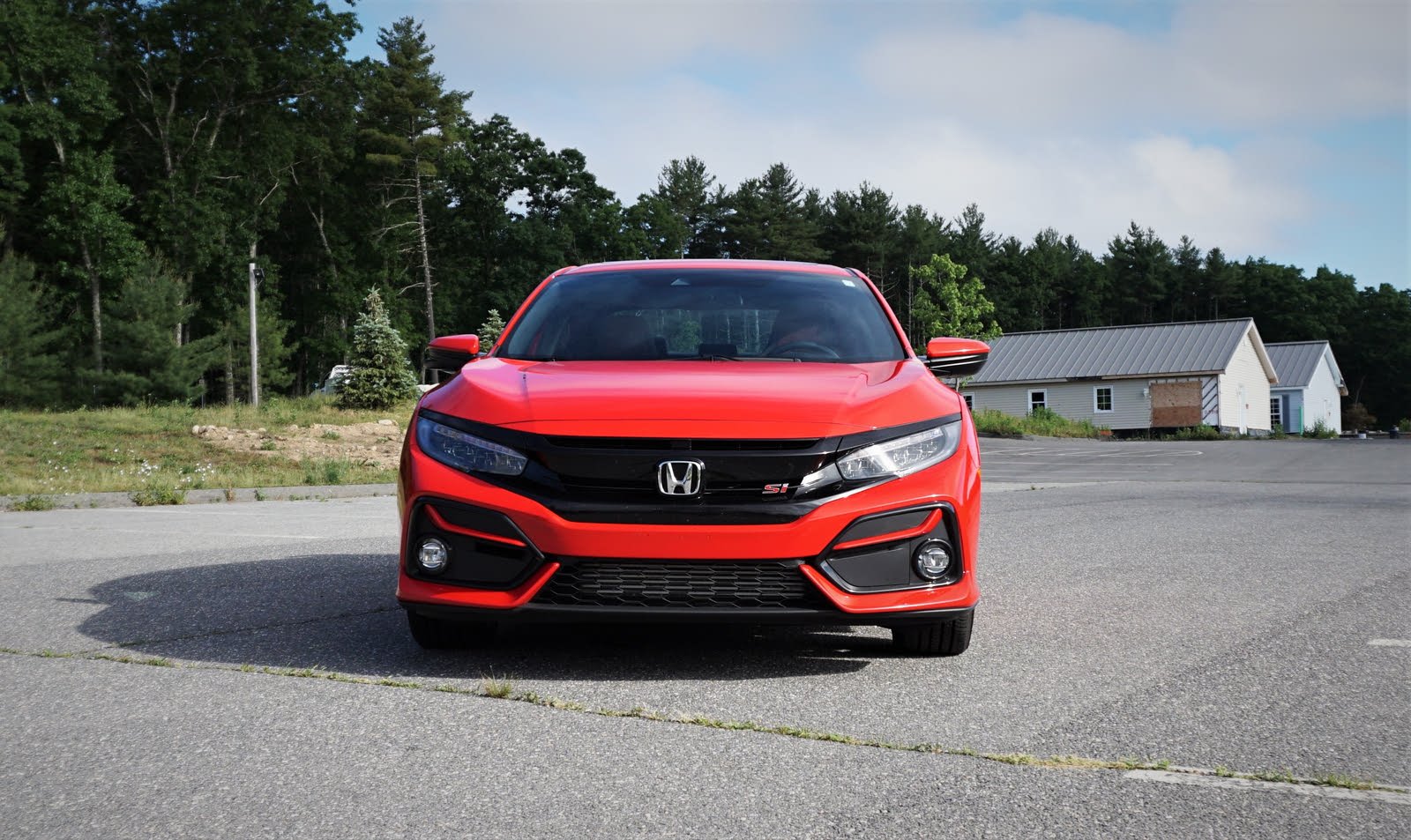
According to CarGurus experts, the overall rating for the 2020 Honda Civic is 8.2 out of 10, while the 2021 Toyota Prius scores 6.2 out of 10. Based on these ratings, the 2020 Honda Civic is the clear winner, offering a better balance of performance, interior quality, and safety features. If you're looking for a well-rounded compact car, the Civic is the better choice.
Choose the 2020 Honda Civic if:
- You want a car with a variety of powerful engine options and excellent driving dynamics.
- You prefer a roomy interior with configurable storage and high-quality materials.
- You value advanced safety features and top safety ratings.
Choose the 2021 Toyota Prius if:
- Fuel efficiency is your top priority, with the L Eco version achieving up to 56 mpg combined.
- You need a car with a spacious interior and versatile cargo space.
- You want a comprehensive suite of standard safety features, including Toyota Safety Sense 2.0.
CarGurus highlights

According to CarGurus experts, the overall rating for the 2020 Honda Civic is 8.2 out of 10, while the 2021 Toyota Prius scores 6.2 out of 10. Based on these ratings, the 2020 Honda Civic is the clear winner, offering a better balance of performance, interior quality, and safety features. If you're looking for a well-rounded compact car, the Civic is the better choice.
Choose the 2020 Honda Civic if:
Shop Now- You want a car with a variety of powerful engine options and excellent driving dynamics.
- You prefer a roomy interior with configurable storage and high-quality materials.
- You value advanced safety features and top safety ratings.
Choose the 2021 Toyota Prius if:
Shop Now- Fuel efficiency is your top priority, with the L Eco version achieving up to 56 mpg combined.
- You need a car with a spacious interior and versatile cargo space.
- You want a comprehensive suite of standard safety features, including Toyota Safety Sense 2.0.

By: CarGurus + AI
At CarGurus, our team of experienced automotive writers remain at the heart of our content operation, conducting hands-on car tests and writing insightful guides that are backed by years of industry experience. To complement this, we are harnessing AI to make our content offering more diverse and more helpful to shoppers than ever. To achieve this, our AI systems are based exclusively on CarGurus content, ratings and data, so that what we produce is both unique to CarGurus, and uniquely helpful to car shoppers.


